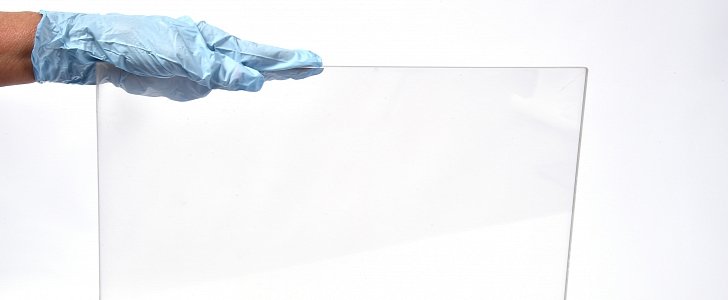You’d think that with a limited amount of prime materials available, humankind would have exhausted all possible combinations by now, but the reality is far from it.
The latest such example is this sheet of… let’s call it “metal” for now, that has the same optical properties as glass but the durability of aluminum. And yet, it’s neither glass, nor metal. It’s called “spinel,” and it’s a special ceramic developed by the United States Naval Research Laboratory (U.S. NRL) over the last ten years.
If you’ve ever seen an iPhone with a cracked display (and you know you have), you’ve already thought of a possible use for this new material. Getting a little more serious than that, its obvious destination would be military vehicles, where it would provide excellent view angles (and, therefore, increased battlefield awareness) without jeopardizing the safety of its passengers.
“Spinel is actually a mineral, it's magnesium aluminate,” said Dr. Jas Sanghera, the lead researcher on the project. “The advantage is it's so much tougher, stronger, harder than glass. It provides better protection in more hostile environments—so it can withstand sand and rain erosion.”
Under laboratory conditions, the NRL managed to produce pieces of eight inches in diameter, but the process is entirely scalable. During the latter stages of development, a company was licensed to produce spinel at an industrial scale, and they came up with 30-inch wide sheets. Ultimately, the size is limited only by the dimensions of the press that’s doing the job.
Shape is not an issue either, since it all comes down to the form of the press. Everything from flat sheets to rounded domes can be achieved without any additional costs.
The best thing about spinel is that it can be synthesized in a laboratory, while all the precursors are earth-abundant, so cost shouldn’t be an issue. Also, even when its durability proves to be overcome, it will chip but it won’t break like glass does.
As with most new materials - and given how this new method of manufacturing spinel was put together by the U.S. NRL - expect it to make it first onto military vehicles of all sorts. Once manufacturing costs go down (there is still a problem with polishing the pieces, at the moment, which is very expensive), we might begin to see spinel used for commercial products. Until then, all we can do is be glad about another scientific breakthrough.
If you’ve ever seen an iPhone with a cracked display (and you know you have), you’ve already thought of a possible use for this new material. Getting a little more serious than that, its obvious destination would be military vehicles, where it would provide excellent view angles (and, therefore, increased battlefield awareness) without jeopardizing the safety of its passengers.
“Spinel is actually a mineral, it's magnesium aluminate,” said Dr. Jas Sanghera, the lead researcher on the project. “The advantage is it's so much tougher, stronger, harder than glass. It provides better protection in more hostile environments—so it can withstand sand and rain erosion.”
Under laboratory conditions, the NRL managed to produce pieces of eight inches in diameter, but the process is entirely scalable. During the latter stages of development, a company was licensed to produce spinel at an industrial scale, and they came up with 30-inch wide sheets. Ultimately, the size is limited only by the dimensions of the press that’s doing the job.
Shape is not an issue either, since it all comes down to the form of the press. Everything from flat sheets to rounded domes can be achieved without any additional costs.
The best thing about spinel is that it can be synthesized in a laboratory, while all the precursors are earth-abundant, so cost shouldn’t be an issue. Also, even when its durability proves to be overcome, it will chip but it won’t break like glass does.
As with most new materials - and given how this new method of manufacturing spinel was put together by the U.S. NRL - expect it to make it first onto military vehicles of all sorts. Once manufacturing costs go down (there is still a problem with polishing the pieces, at the moment, which is very expensive), we might begin to see spinel used for commercial products. Until then, all we can do is be glad about another scientific breakthrough.

